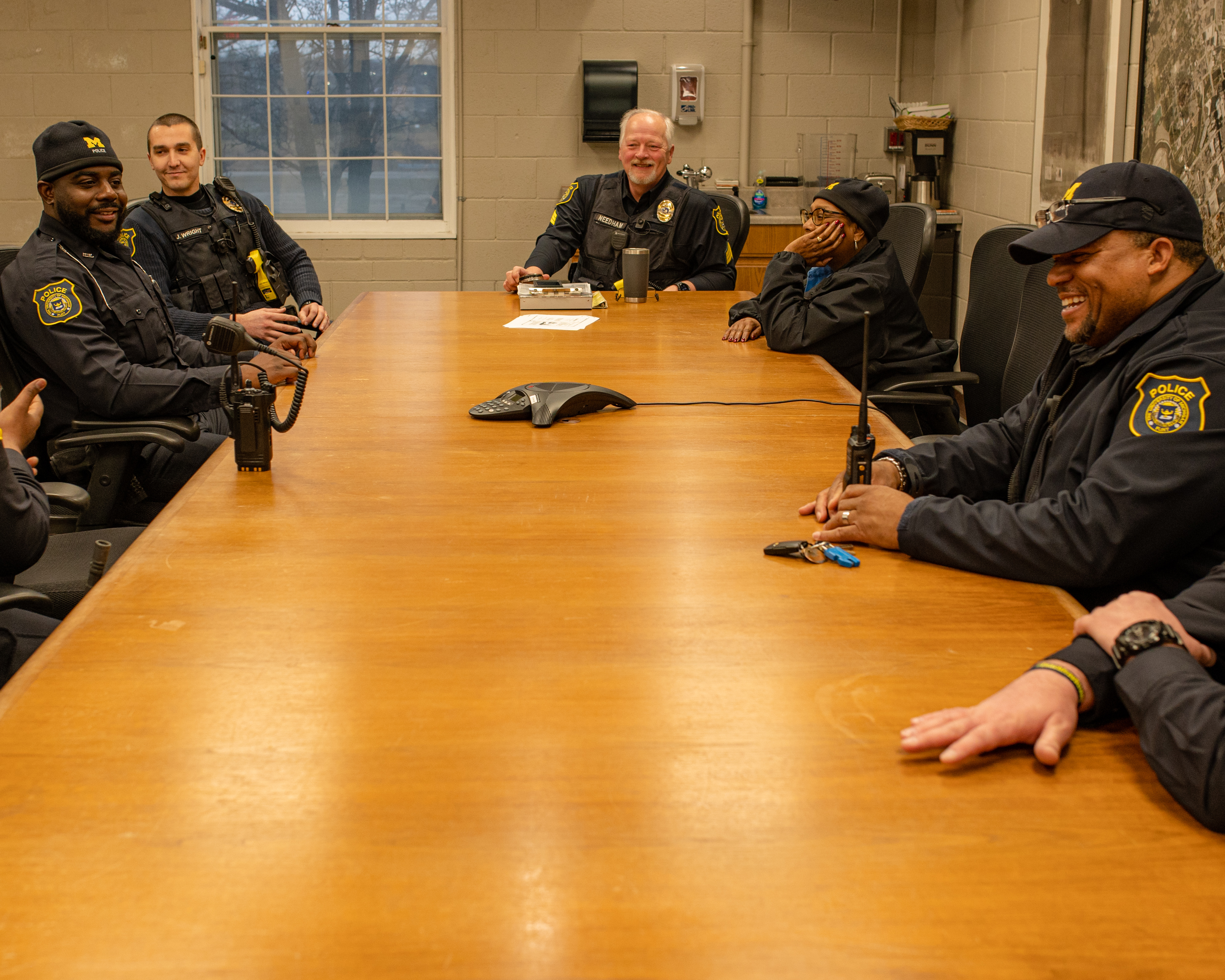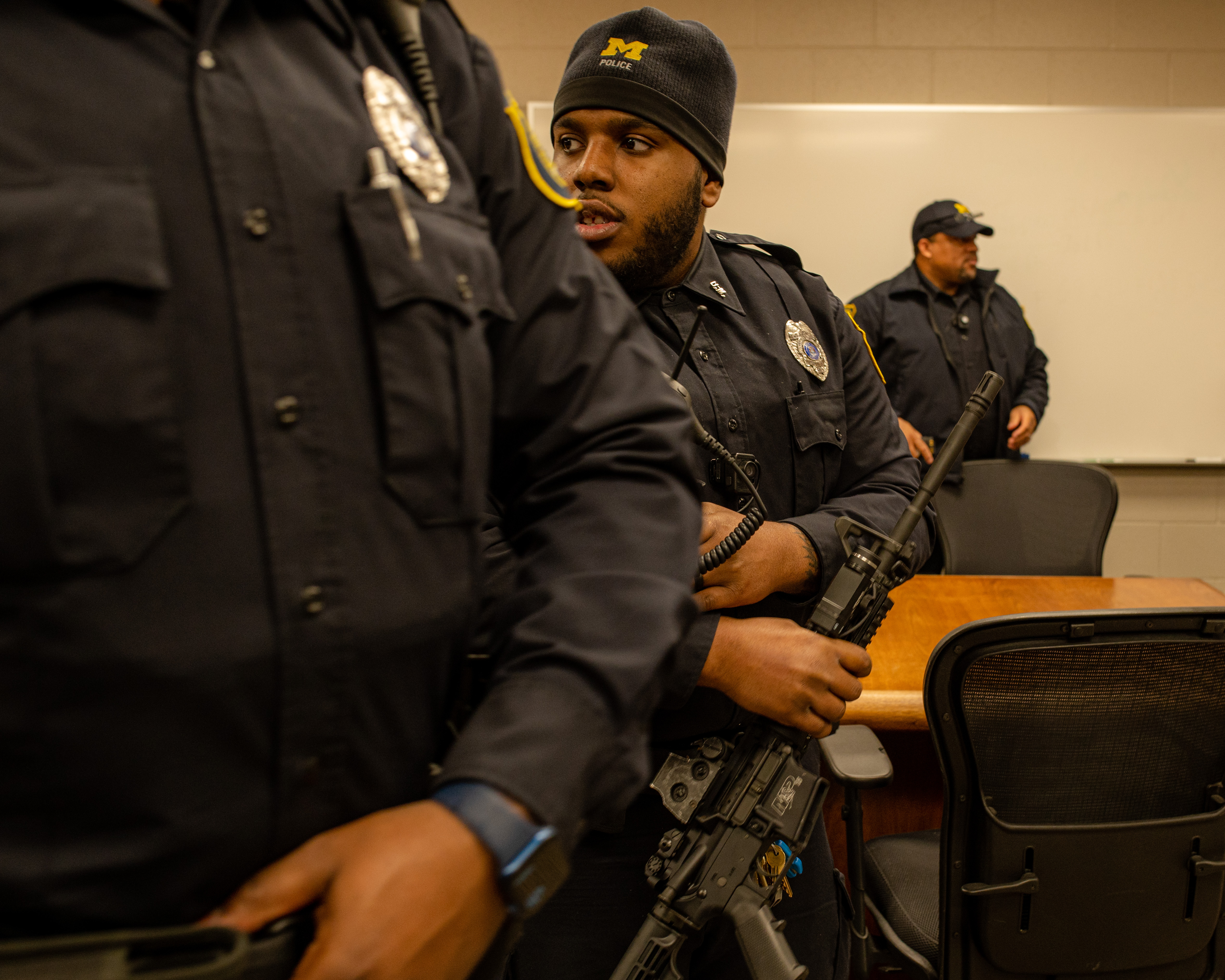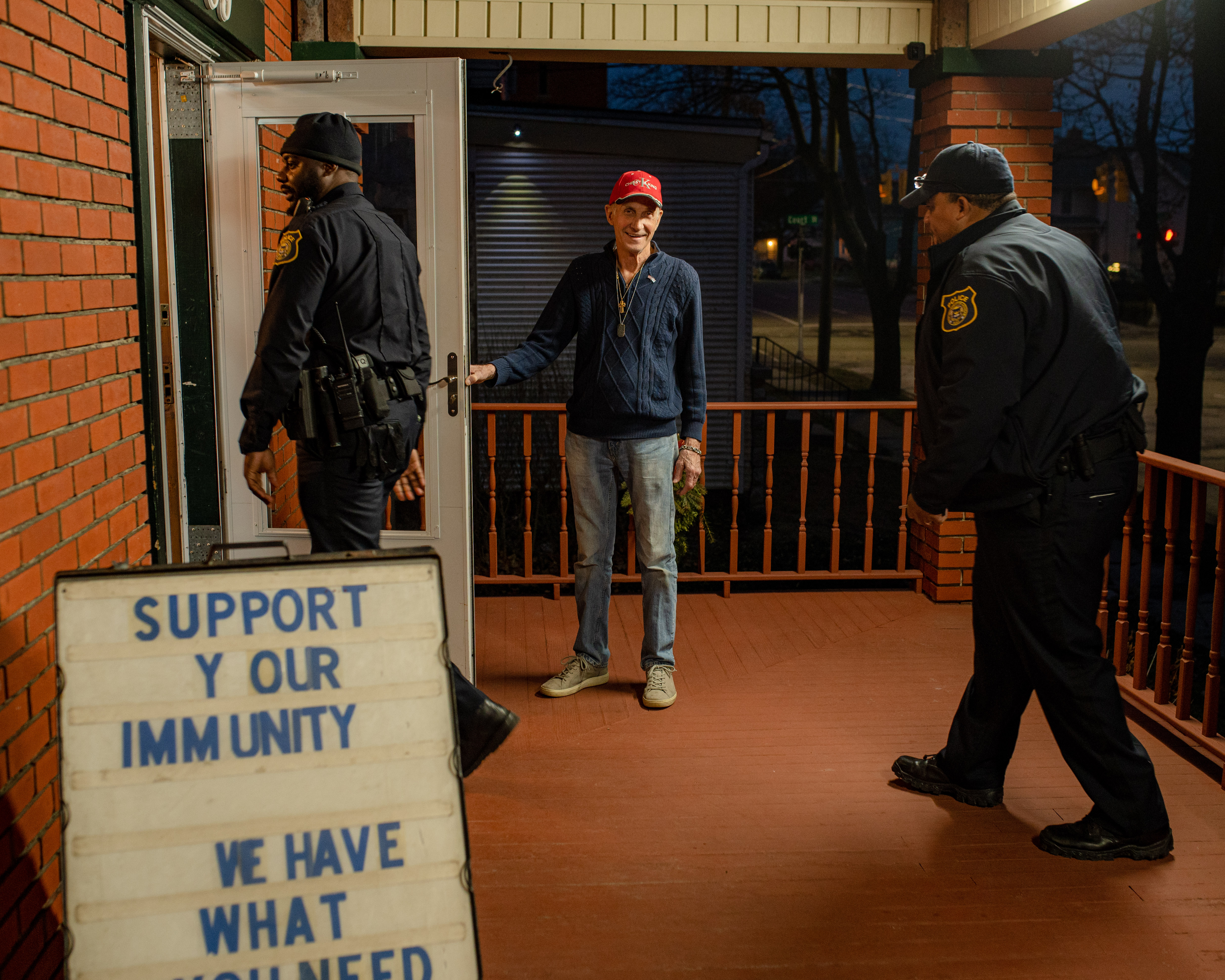Flint, MI—Almost three weeks ago, the University of Michigan-Flint Department of Public Safety launched a new initiative to reduce crime and improve 911 response time in downtown Flint.
From 4 p.m. to midnight, Monday through Saturday, the department is now the first responder to 911 calls in the city’s downtown, an area roughly defined by officers as Grand Traverse Street to Chavez Drive and Fifth Avenue to Court Street.
The effort grew out of a strategy the department had already been championing under the university’s public safety director, Chief Ray Hall, an approach to crime prevention known as problem-oriented policing (POP).
“I wish I could tell you that [POP] was innovative and creative, it’s neither,” Hall told Flint Beat from his wood-paneled office on the UM-Flint campus. “It is research-based initiatives that have had a positive impact on reducing crime and violence.”
Innovative or not, the greater possibility of the department’s approach and new initiative goes beyond reducing crime and 911 response time downtown.
Having UM-Flint police patrol the city’s core effectively frees up City of Flint and Genesee County officers to respond more quickly to 911 calls across the rest of the city—a years’ long concern for residents.

What is problem-oriented policing?
According to public policy think tank RAND Corporation, problem-oriented policing “means diagnosing and solving problems that are increasing crime risks, usually in areas that are seeing comparatively high levels of crime.”
For UM-Flint officers, though, the approach is less textbook, more personal in practice.
As Hall explained, the department phased in its 911 initiative by first announcing expanded patrol borders and beginning downtown foot patrols in the fall of 2022. The next and ongoing phase, he said, was community building.
“We have monthly meetings on the first Thursday of every month at 8:30 a.m. at the Mott Culinary School,” he said, excitedly searching his office for an easel-sized notepad from the most recent gathering.
“So if you come, you’ll see these sticky things on the wall,” Hall said, pulling off the notepad’s first sheet, filled with black permanent-marker notations, and pressing it to his office door.
Hall pointed to a scribbled note on “lighting” to give an example of how problem-oriented police response works.
He explained that at one of the department’s first meetings, attendees—who are not asked for names or contact information—had raised concerns over downtown Flint’s many burned-out bulbs. They said the pockets of darkness made them feel unsafe walking around at night.
“So, we did a lighting assessment,” Hall said. The idea being that POP is about problem-solving—even if a fix for a community safety concern doesn’t come directly from his department.
“Part of this is we come back in with resources, right? We may have connectivity that the community member may not have,” he said.
Ultimately, Hall said he took the lighting assessment his officers did directly to Consumers Energy—”UM-Flint is a big customer”—and asked the company to prioritize fixing the dozens of streetlights the team identified.
It may seem strange using police time to look at some lights, Hall acknowledged, but the example speaks to the power of problem-oriented policing: the community is involved, police are hopefully viewed as helpful and open to feedback, and then everyone ends up working together to reduce crime.
“We never forget what the goal is,” he said. “We want a welcoming, inclusive, safe community in downtown.”


Does it work?
As Hall noted, problem-oriented policing isn’t new. While the approach may not always be referred to as POP across police departments, the strategy itself has been in play for over a decade in other areas of Michigan.
For example, Wayne State University took up a similar, collaborative approach to policing around 2009, according to Assistant Chief Patrick Saunders.
Unlike UM-Flint’s officers, Wayne State’s police department had always been patrolling beyond campus borders, Saunders said, but a local initiative saw that work become more goal-driven at the time.
“What happened is around 2008 into 2009, Wayne State University, Henry Ford Hospital and Detroit Medical Center had come up with a program called ’15 by 15,’ which essentially meant they…wanted to increase the population by 15,000 people living here by 2015,” Saunders explained. “Part of that plan was a public safety element.”
Saunders said the department secured foundation grants, much like UM-Flint has, to hire more officers and be more proactive in its law enforcement work.
It also introduced Computerized Statistics (CompStat), which UM-Flint officers also use, to help identify high crime areas and analyze department responses to crimes in a timely way.
In other words, Saunders said, “[CompStat] was being used to see if what we were doing was working.”
Now, 14 years later, the data suggests that it is.
“The numbers are down,” said Dave Martin, a research professor at Wayne State’s Center for Urban Studies of the Midtown Detroit area covered by university police. Martin has been working with police data for over 25 years, and compiles and shares his research with the university’s police and other stakeholders at bi-weekly meetings. “Overall crime is down about 65 percent, and predatory crimes—the more random ones where it’s a stranger breaking into home, or breaking into a car, or a street robbery—those numbers are down by 75 percent.”
Hall said he’d been inspired by Wayne State’s success, but he was also already a firm believer in POP from his former work in Lansing, Mich. There, as North Precinct Commander for the Lansing Police Department (Lansing PD), he worked with Michigan State University’s School of Criminal Justice to identify and prevent crimes in hot spot areas.
“This is where Preuss Pets shop comes in,” Hall said back at his office, the large sticky note still affixed to his door. “We met with [the owner] in Lansing and he goes, ‘Look, I’m in Okemos, [Mich.] and I want to come downtown, but … can you make it safe?’”
Hall said the Lansing PD response to Preuss’ concerns—stopping in, being more visible in the area, asking for owner and staff feedback—is one of the major reasons he believes in the POP approach.
The store, he said, shows that incorporating community into police work can be a benefit for everyone. It’s why he believes that having UM-Flint officers join Flint’s downtown policing strategy will not only reduce police response time and attract more visitors, it will attract more businesses too.
After all, Pruess Pets has now been in the Old Town area of Lansing since 2005, the chief noted with a smile.

Early Days and Potential Challenges
During a ride along on Wednesday, Jan. 18, just two days after UM-Flint’s public safety department launched its downtown 911 initiative, UM-Flint Officers James Wheeler and Nickoy Edwards encountered their first issue.
“Let me write my ID number down because I’ve never heard of it,” Edwards said into his radio while grabbing a pen. This resulted in a chuckle from Wheeler, who was in the driver’s seat.
The pair were setting up contact with their dispatcher for the evening, but now that they were dealing with agencies beyond their campus department, their usual call numbers weren’t relevant.
“Call me whatever you’d like to call me,” Wheeler joked to the same dispatcher before snagging Edwards’ pen to jot down the number a crackling voice shared over the radio.
Both Wheeler and Edwards are former Flint Police Department officers and said that they were happy to be supporting their friends and former colleagues from their new posts at UM-Flint. Wheeler said he’d been nearly ready to retire from the force when he spoke to Chief Hall about problem-oriented policing and wanted to get involved.
“We’re in a position now to slow down and smile and take care of folks,” Wheeler said of why he likes the approach. “I tell you what’s so important are those quality of life issues. We’re allowed to do that…you can take care of small things before they turn into big things.”


Edwards nodded as Wheeler explained how handling the little stuff—loud music, debris in the street—can stop those things from leading to “big things” like violence at a house party or illegal dumping.
Edwards added that his “why” for joining the force, and then following Wheeler to UM-Flint, was the opportunity to support his community through this more proactive, less reactive approach to law enforcement.
“I went to high school here,” Edwards said. “My ‘why’ is to give back to the community and continue to reciprocate that and then try to prevent other people, or young people, from going into the criminal justice system in the first place.”
Edwards said he felt the POP approach could be a draw for new recruits, as it allows for more opportunities to connect directly with the people officers are sworn to protect and serve. And, for him, that’s a win.

“You know, if I can reach someone, just one kid, I would say I did my job,” he said.
Over the course of their patrol the pair stopped into local businesses and greeted owners by name. They cruised around downtown Flint, dropped in on a class for youth interested in future careers in law enforcement and waved at or talked with passing pedestrians and motorists.
Both officers were generally met with smiles and waves too—noteworthy given years of protests around law enforcement in the wake of publicized police killings, such as the deaths of George Floyd and Breonna Taylor. Flint Beat asked what it was like for Wheeler and Edwards to do such work in a potentially unwelcoming environment.
“Perception is everything,” Wheeler responded, adding that he believes the POP approach invites not only a change in perception of downtown safety but in the perception of police in general.
Now when a cop rolls up, he said, he hopes people in downtown Flint expect a friendly hello, some help with a parking meter or just an ask about how their night is going.
“It’s no longer arrests, tickets, totals—that’s not the agenda,” he said, turning down Buckham Alley. “The agenda is to affect change and help people to understand that.”

While Assistant Chief Saunders at Wayne State noted that early challenges for UM-Flint’s new initiative might include things like building confidence in officers or difficulty in gaining community support, Dr. Edward McGarrell of Michigan State University’s School of Criminal Justice, who was integral to Chief Hall’s former work in Lansing, said he thought the challenges ahead were perhaps more nuanced.
“The approach we’re taking is, in some ways, kind of a philosophical approach as opposed to one specific strategy,” McGarrell said. Thus, trying to talk about what “success” looks like for the effort goes beyond just seeing a decrease in crime, he said, it’s about constantly assessing whether responses are working to lessen—and not just displace—issues.
“I’m not under any illusion that every person who’s involved in selling drugs immediately decides to go into a different line of business when you close an operation,” McGarrell said. “But what tends to happen is—when you tamp down these recurring problems [through POP]… you get what the researchers refer to as ‘a diffusion of benefits.’”
McGarrell said research shows that a lot of violent crime tends to be retaliatory, with one dispute leading to another, so “if you kind of interrupt those patterns with this problem-oriented approach, it seems to be pretty powerful.”
Hall himself said what he anticipated would be an issue with the POP approach—getting City and Genesee County law enforcement agencies onboard—has not been an issue at all.
He noted his team had an “inspiring” visit from Mayor Sheldon Neeley and Flint Police Chief Terrence Green, and he mentioned sharing real-time intelligence with the Genesee County Sheriff’s Office for the first time, calling the office “a key partner.”
“This has been wonderful… the experience we’ve had,” Hall said of the 911 initiative’s implementation.
Still, being in its early days, Assistant Chief Saunders back at Wayne State said he had one more piece of advice for Flint officers and residents hungry for results: “People have to have patience, it’s not going to change overnight.”
The first two years of Wayne State PD’s initiative were difficult, Saunders explained, before the many stakeholders got to a more stable level of operation. And, as Professor Martin later added, there’s a seeming increase in crime before there’s a decrease, given that a more proactive approach means an uptick in crime numbers before trending downward or leveling out.
But, Chief Hall noted, that longer-term understanding is worth UM-Flint officers’ efforts in a city with a priority one 911 response time that can be upwards of 30 minutes.
“A downtown has to be the hub of the wheel, not the hole of the donut,” Hall concluded. “The downtown needs to have vibrancy. The downtown needs to bring in businesses and opportunities so that uptown—the north side of town, and the west side of town, and the south side of town and the east side of town—can enjoy vibrancy as well. …We’re very optimistic that vibrancy is coming.”

Editor’s Note: An earlier version of this story did not specify that “priority one” (indicating an immediate threat to life) 911 response time by Flint PD can be upward of 30 minutes. The article has been updated to clarify that information, which was originally shared by Flint Police Chief Terence Green in April 2022.

